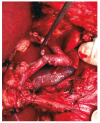RISK FACTORS ASSOCIATED WITH HEPATIC ARTERY THROMBOSIS: ANALYSIS OF 1050 LIVER TRANSPLANTS
- PMID: 33503116
- PMCID: PMC7836077
- DOI: 10.1590/0102-672020200004e1556
RISK FACTORS ASSOCIATED WITH HEPATIC ARTERY THROMBOSIS: ANALYSIS OF 1050 LIVER TRANSPLANTS
Abstract
Background: Hepatic artery thrombosis is an important cause of graft loss and ischemic biliary complications. The risk factors have been related to technical aspects of arterial anastomosis and non-surgical ones.
Aim: To evaluate the risk factors for the development of hepatic artery thrombosis.
Methods: The sample consisted of 1050 cases of liver transplant. A retrospective and cross-sectional study was carried out, and the variables studied in both donor and recipient.
Results: Univariate analysis indicated that the variables related to hepatic artery thrombosis are: MELD (p=0.04) and warm time ischemia (p=0.005). In the multivariate analysis MELD=14.5 and warm ischemia time =35 min were independent risk factors for hepatic artery thrombosis. In the prevalence ratio test for analysis of the anastomosis as a variable, it was observed that patients with continuous suture had an increase in thrombosis when compared to interrupted suture.
Conclusions: Prolonged warm ischemia time, calculated MELD and recipient age were independent risk factors for hepatic artery thrombosis after liver transplantation in adults. Transplanted patients with continuous suture had an increase in thrombosis when compared to interrupted suture. Re-transplantation due to hepatic artery thrombosis was associated with higher recipient mortality.
Racional:: Trombose de artéria hepática é importante causa de falência de enxerto e complicações biliares. Fatores de risco para trombose estão relacionados aos aspectos técnicos da anastomose arterial e fatores não cirúrgicos.
Objetivo:: Avaliar os fatores de risco para o desenvolvimento de trombose de artéria hepática.
Métodos:: A amostra consta de 1050 casos de transplante hepático. Foi realizado estudo retrospectivo e transversal, e as variáveis foram avaliadas em doadores e receptores.
Resultados:: A análise univariada mostrou que as variáveis relacionadas a trombose de artéria hepática são: MELD e tempo de isquemia quente. Na análise multivariada, o MELD=14.5 e tempo de isquemia quente =35 min foram fatores de risco independentes para trombose de artéria hepática. No teste de prevalência para avaliação do tipo de anastomose como variável, foi observado que a sutura contínua tem maior risco de trombose quando comparada com aquela em pontos separados.
Tempo de isquemia quente prolongado, MELD calculado e idade do recipiente foram fatores de risco independentes para trombose de artéria hepática após transplante de fígado em adultos. Pacientes submetidos à anastomose com sutura contínua apresentaram mais trombose quando comparados com a em pontos separados. Retransplante por trombose está associado com maior mortalidade.
Conflict of interest statement
Figures



References
-
- Abou El-Ella K, Al Sebayel M, Ramirez C. Outcome and risk factors of hepatic artery thrombosis after orthotopic liver transplantation in adults. Transplant Proc. 2001;33:2712–2712. - PubMed
-
- Bekker JM, Ploem S, De Jong KP. Early hepatic artery thrombosis after liver transplantation a systematic review of the incidence, outcome and risk factors. Am J Transplant. 2009;9:746–757. - PubMed
-
- Bonney GK, Aldersley MA, Asthana S. Donor Risk Index and MELD Interactions in Predicting Long-Term Graft Survival A Single-Centre Experience. Transplantation. 2009;87:1858–1863. - PubMed
-
- Boyvat F, Aytekin C, Harman A. Endovascular stent placement in patients with hepatic artery stenoses or thromboses after liver transplant. Transplant Proc. 2008;40:22–26. - PubMed
Publication types
MeSH terms
LinkOut - more resources
Full Text Sources
Medical

